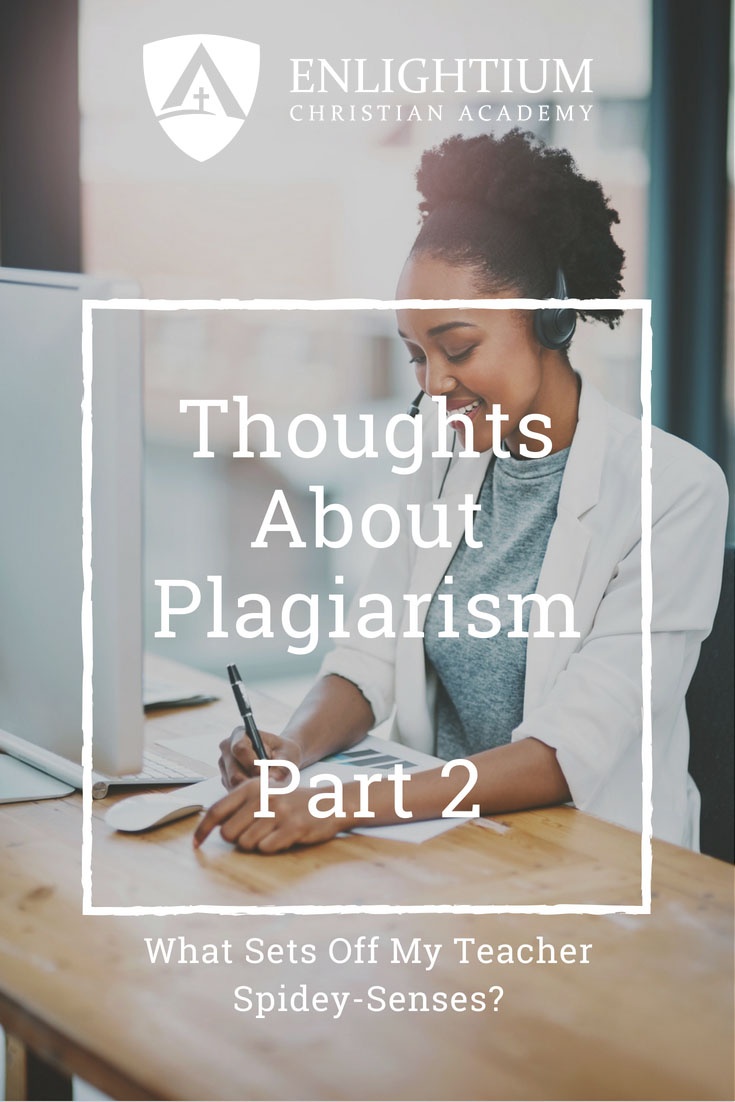Dear Students,
Plagiarism is a topic that is always discussed in specific ways. It’s outlined in school policies, and teachers explain the consequences and moral implications. The messages we as teachers convey about plagiarism by setting out the rules are important, but they are also incomplete. This open letter format is my attempt to continue the conversation with openness and hopefully some humor.
This is the second entry in a series discussing plagiarism. You can read Part 1: An Open Letter to Students Dispelling Myths About Plagiarism.

I want to start by emphasizing, as I mentioned in Part 1, that I neither enjoy catching students who are plagiarizing, nor do I automatically assume students who write good papers are plagiarizing. Above all, I don’t willy-nilly accuse students of plagiarism. I am well aware that some of the things that can look like plagiarism can also happen if someone is not plagiarizing, which is why they raise suspicions, but are never counted as proof. I don’t address the question of plagiarism with a student unless I have checked and have evidence, and even then I try to ask questions rather than make accusations.
So, what makes me suspicious? Well, there are a few different things that activate my spidey sense, though this is not necessarily an exhaustive list. I’m also not concerned that this list will help students to become better at plagiarism, since these are really not things you can avoid if you are plagiarizing.
The essay or information does not quite fit the prompt.
The truth is that most plagiarism is like trying to shove a square peg in a round hole. It kinda fits, but not quite. It’s like giving a really good definition of a turkey dinner, when you are supposed to actually serve a Thanksgiving meal - same topic, different result.
The answer is outrageously and completely incorrect.
Not as in, you misunderstood the material incorrect, but as in “The snowman in To Kill a Mockingbird can sing and dance like the snowman in Frozen” (thank you Answers.com). We also see answers that have been clearly copied directly from the Internet without being read. I say clearly, because sometimes an answer to a question literally says “Don’t plagiarize. It’s wrong.”
I’ve seen the exact same wording before.
If you’ve found an answer on the Internet, it’s a good bet you’re not the only student who has found that answer, or even the first student who found that answer and copy/pasted it onto your assignment.
A student refuses to make any corrections to their essay.
Yes, I know this can just mean a student is busy, but often students who plagiarize are not willing to make revisions, because they don’t know anything about the material.
A student does make revisions...
...but the revisions are in a completely different style from the rest of the paper. Writing styles are like signatures. Revisions that sound casual and chatty after several paragraphs that are textbook formal is an easy way to activate my teacher-radar.
A student submits a polished paper that is in a completely different style...
...from everything they have submitted before, including drafts and other assignments. It is true that some students simply don’t turn in their best efforts on drafts. Hey, I was one of these students. However, it’s important to remember that by the time you turn in your report I’ve read a lot of your writing, and I know approximately what you “sound like” and what your writing level is. Which means that something written by a stranger stands out, sometimes because it’s at a higher level than I’ve ever seen from the student, and sometimes because it’s just inconsistent with how the student usually writes.
A paper contains sections that are very different in style from the rest of the paper.
It might have been written on a different day or when the student was hangry, but by and large, a person’s voice within an essay tends to be mostly consistent.
A student submits a polished essay after refusing to do any of the prewriting or drafting.
I know there are students who prefer to write essays all at once, and for whom pre-writing is torture. But multiple rounds of writing and reviewing not only allows a student to continually improve an essay, but it is also a good way for teachers to see that you are doing your work yourself.
A student has a history of plagiarism.
Students can turn over a new leaf, which teachers and parents love to see. On the other hand, when there is documentation that shows a student often plagiarizes, I’m going to double-check.
An essay has odd errors in capitalization or punctuation.
Kind of like it’s been pieced together from several different sources. The result is Frankenstein’s monster: There are random capital letters sticking out of the middle of sentences, jarring differences in font and sometimes there are left-over hyperlinks. It’s not pretty.
I know plagiarism is a difficult topic to discuss, and the last thing I would want to do is make someone feel like I am accusing him or her when they would never plagiarize. I do, in fact, know that the majority of my students don’t plagiarize. But I also know that in a digital age, where everything is at your fingertips, it’s a temptation and that understanding what is and isn’t plagiarism can be difficult. So I am asking you to engage with your teachers on this topic and let them know if you have any questions or comments.
Enlightium Academy is an accredited alternative schooling option for educating your child from home. Our program offers the comfort of a homeschool environment with a quality private school curriculum. Enlightium Academy is a private Christian school that offers a Bible-based, flexible, accredited, teacher supported, and affordable education. Enlightium Academy meets all accreditation and state education requirements for all 50 states, while neither using the state curriculum or Common Core.
